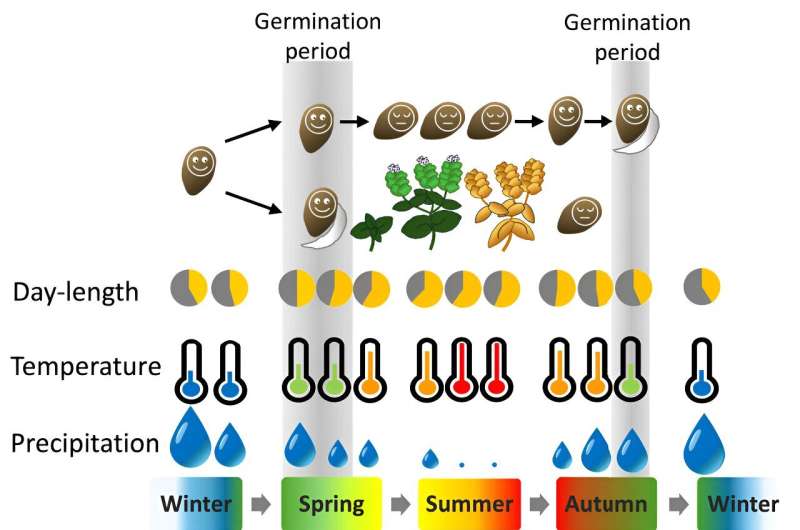This article has been reviewed according to Science X's editorial process and policies. Editors have highlighted the following attributes while ensuring the content's credibility:
fact-checked
peer-reviewed publication
trusted source
proofread
Summer slumber: How seeds go dormant to combat harsh conditions

Plants are highly versatile organisms that have developed remarkable strategies to adapt to different environments. One such strategy is seed dormancy, an adaptation that temporally prevents viable seeds from germinating even under optimal conditions, when the subsequent seedling development is of high risk.
In Mediterranean climates like that of Cyprus, summers can be excessively harsh, with very high temperatures and dry terrain. In such regions, germinating during the summer months would expose seedlings to potentially fatal conditions. A Cyprus-specific subspecies of Aethionema arabicum has developed a fascinating adaptation to stop seeds from germinating before or during the hot, dry summer months.
Zsuzsanna Mérai, postdoctoral researcher in the group of Liam Dolan and formerly in the group of Ortrun Mittelsten Scheid at the GMI, now described the molecular basis of this adaptation in their study published in Current Biology.
Let there be light: Long days induce secondary seed dormancy
Last year, a team of researchers led by Zsuzsanna Mérai described that direct light exposure can inhibit germination of Aethionema arabicum seeds. In their new study, the team studied whether light exposure could result in long-term suppression of germination, known as secondary dormancy.
Interestingly, the team found that secondary dormancy depends on the daily length of the light exposure. "This mechanism makes a lot of sense: day length is a much more stable condition than temperature or humidity, which may vary significantly from one day to the next," explains Mérai. Indeed, days become longer in summer, which leads to seeds being exposed to light for a longer period.
"Aethionema seeds use this information to set up their germination in early spring, when the weather conditions are ideal for seedling development," Mérai says. "When the days become too long, that signals to the seeds that summer is coming, and they shouldn't germinate anymore."
The researchers discovered that exposing seeds to 16 hours of light per day resulted in long-term suppression of germination maintained even in the absence of light. "Even if we put the seeds back to dark conditions, they will not germinate because they will remember that the conditions were not good for sprouting," Mérai summarizes.
RGL2's pivotal role in light-induced dormancy
While secondary dormancy was a known phenomenon, how this process is induced at a molecular level was not yet described. By screening a library of mutated seeds where secondary dormancy couldn't be established, the researchers identified protein RGL2 as the main regulator of secondary dormancy establishment.
"Seeds with mutations in the RGL2 gene are still inhibited by light, but only short term. Lacking RGL2, secondary dormancy induction fails," explains Mérai. To better understand this process, the researchers studied which pathways are regulated by RGL2.
"We identified 3.300 genes that are associated with secondary dormancy, including upregulated pro-dormancy genes, and negative regulators of dormancy which are downregulated," Mérai adds.
A hormonal balancing act
Previous studies had shown that dormancy resulted from the interplay between a dormancy-promoting plant hormone called abscisic acid (ABA) and a dormancy-repressing hormone called gibberellin (GA). As expected, the researchers observed that RGL2 repressed GA production and increased ABA biosynthesis in seeds exposed to light.
However, the group made a striking discovery: only one of the hormones was essential to inducing secondary dormancy. "We found that artificially reducing GA levels induces seed dormancy, while increasing ABA levels doesn't," Mérai explains.
From lab to field: Harnessing heat adaptation for crop resilience
These results shed light on how some plants adapt their germination patterns to avoid harsh summer conditions, a process contrary to canonical models in which light induces germination. "Some plants seem to have tweaked germination to adapt to specific climates," Mérai points out.
Interestingly, the team showed that the summer heat and drought are key factors to make seeds exit their dormant state. "Simulating summer by dehydrating seeds to temperatures over 40 degrees alleviates dormancy so that seeds can sprout when conditions may be favorable again," explains Mérai.
The researchers intend to study whether other plants use similar systems to adapt to harsh climates. If so, their discovery could have important implications for crop seeding, as well as open a potential path to engineering germination adaptation in other species, says Mérai. "Our findings could be applied to make new crops that are better adapted to warmer climates and the continuously rising temperatures," he adds.
More information: Zsuzsanna Mérai et al, Long days induce adaptive secondary dormancy in the seeds of the Mediterranean plant Aethionema arabicum, Current Biology (2024). DOI: 10.1016/j.cub.2024.05.043
Journal information: Current Biology


















